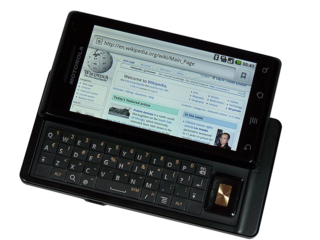Related Research Articles

Motorola, Inc. was an American multinational telecommunications company based in Schaumburg, Illinois. It was founded in 1928 as Galvin Manufacturing Corporation by brothers Paul and Joseph Galvin. The company changed its name to Motorola in 1947. After having lost $4.3 billion from 2007 to 2009, Motorola was split into two independent public companies, Motorola Mobility and Motorola Solutions, on January 4, 2011. The reorganization was structured with Motorola Solutions legally succeeding Motorola, Inc., and Motorola Mobility being spun off.
Freedom of information laws allow access by the general public to data held by national governments and, where applicable, by state and local governments. The emergence of freedom of information legislation was a response to increasing dissatisfaction with the secrecy surrounding government policy development and decision making. In recent years Access to Information Act has also been used. They establish a "right-to-know" legal process by which requests may be made for government-held information, to be received freely or at minimal cost, barring standard exceptions. Also variously referred to as open records, or sunshine laws, governments are typically bound by a duty to publish and promote openness. In many countries there are constitutional guarantees for the right of access to information, but these are usually unused if specific support legislation does not exist. Additionally, the United Nations Sustainable Development Goal 16 has a target to ensure public access to information and the protection of fundamental freedoms as a means to ensure accountable, inclusive and just institutions.

Wardriving is the act of searching for Wi-Fi wireless networks, usually from a moving vehicle, using a laptop or smartphone. Software for wardriving is freely available on the internet.

The Freedom of Information Act, 5 U.S.C. § 552, is the United States federal freedom of information law that requires the full or partial disclosure of previously unreleased or uncirculated information and documents controlled by the U.S. government, state, or other public authority upon request. The act defines agency records subject to disclosure, outlines mandatory disclosure procedures, and includes nine exemptions that define categories of information not subject to disclosure. The act was intended to make U.S. government agencies' functions more transparent so that the American public could more easily identify problems in government functioning and put pressure on Congress, agency officials, and the president to address them. The FOIA has been changed repeatedly by both the legislative and executive branches.

Crime mapping is used by analysts in law enforcement agencies to map, visualize, and analyze crime incident patterns. It is a key component of crime analysis and the CompStat policing strategy. Mapping crime, using Geographic Information Systems (GIS), allows crime analysts to identify crime hot spots, along with other trends and patterns.
Public records are documents or pieces of information that are not considered confidential and generally pertain to the conduct of government.
Android is a mobile operating system based on a modified version of the Linux kernel and other open-source software, designed primarily for touchscreen mobile devices such as smartphones and tablets. Android is developed by a consortium of developers known as the Open Handset Alliance, though its most widely used version is primarily developed by Google. It was unveiled in November 2007, with the first commercial Android device, the HTC Dream, being launched in September 2008.
CrimeView is a crime analysis, mapping and reporting software extension to ArcGIS. It is designed for the detailed study of patterns of crime as they relate to geography and time.

Here Technologies is a Dutch multinational group specialized in mapping technologies, location data and related automotive services to individuals and companies. It is majority-owned by a consortium of German automotive companies and American semiconductor company Intel whilst other companies also own minority stakes. Its roots date back to U.S.-based Navteq in 1985, which was acquired by Finland-based Nokia in 2007. Here is currently based in The Netherlands.
In 2018, Tyler Technologies acquired Socrata, a business-to-government software company, that sells an "open data platform" whose goal was to help "civic developers build apps more efficiently."

The Motorola Droid is an Internet and multimedia-enabled smartphone designed by Motorola, which runs Google's Android operating system. The Droid had been publicized under the codenames Sholes and Tao and the model number A855. In Latin America and Europe, the model number is A853 (Milestone), and in Mexico, the model number is A854 (Motoroi). Due to the ambiguity with newer phones with similar names, it is also commonly known as the DROID 1. The brand name Droid is a trademark of Lucasfilm licensed to Verizon Wireless.

The Open Government Initiative is an effort by the administration of President of the United States Barack Obama to "[create] an unprecedented level of openness in Government.". The directive starting this initiative was issued on January 20, 2009, Obama's first day in office.
RAIDS Online is a free public crime map developed by BAIR Analytics. It aims to reduce information requests and improve trust between law enforcement entities and their public with data accuracy and transparency.

Moto X is an Android smartphone developed and manufactured by Motorola Mobility, and released in August 2013.

Corruption is endemic at every level of Liberian society, making Liberia one of the most politically corrupt nations in the world. As such, corruption is not specifically a punishable crime under Liberian law, which further exacerbates the nature of corruption present in the country. When President Sirleaf took office in 2006, she announced that corruption was “the major public enemy.”
Access to public information and freedom of information (FOI) refer to the right of access to information held by public bodies also known as "right to know". Access to public information is considered of fundamental importance for the effective functioning of democratic systems, as it enhances governments' and public officials' accountability, boosting people participation and allowing their informed participation into public life. The fundamental premise of the right of access to public information is that the information held by governmental institutions is in principle public and may be concealed only on the basis of legitimate reasons which should be detailed in the law.

Illinois Public Access Opinion 16-006 is a binding opinion issued in 2016 by the Illinois Attorney General pursuant to the state's Freedom of Information Act (FOIA). Issued in the aftermath of the murder of Laquan McDonald, the opinion addressed a public records request from CNN for private emails by officers of the Chicago Police Department (CPD) related to the incident. After CPD denied CNN's request, the Attorney General's office, led by Lisa Madigan, ruled that the police officers' private emails about McDonald's murder were subject to public disclosure, even though those emails were communicated on accounts outside of the police department's email servers. The binding opinion was later upheld by the Circuit Court of Cook County, though CNN never received the records that it had requested.

The Illinois Freedom of Information Act, 5 ILCS 140/1 et seq., is an Illinois statute that grants to all persons the right to copy and inspect public records in the state. The law applies to executive and legislative bodies of state government, units of local government, and other entities defined as "public bodies". All records related to governmental business are presumed to be open for inspection by the public, except for information specifically exempted from disclosure by law. The statute is modeled after the federal Freedom of Information Act and serves a similar purpose as freedom of information legislation in the other U.S. states.

The Illinois Public Access Counselor (PAC) is an attorney in the office of the Illinois Attorney General who is responsible for enforcing the state's Freedom of Information Act (FOIA) and Open Meetings Act (OMA). The PAC is the head of the Public Access Bureau, a group of more than one dozen attorneys who process complaints against public bodies and provide education to the public on Illinois' transparency laws.

City of Champaign v. Madigan, 2013 IL App (4th) 120662, 992 N.E.2d 629 (2013), is a case decided by the Illinois Appellate Court in 2013 concerning the state's Freedom of Information Act (FOIA). The court ruled that messages sent and received by elected officials during a city council meeting are subject to public disclosure, even when those communications are stored on personal electronic devices. The case addressed a public records request from a reporter for The News-Gazette in Champaign, Illinois, who observed Champaign city council members and the mayor using their personal electronic devices to send messages, outside the public's view, during a city council meeting.
References
- ↑ "Baltimore's SpotCrime just added a national missing persons database". Technical.ly Baltimore. May 14, 2021.
- ↑ crime tip application CrimeTip.us
- ↑ "Survey and Evaluation of Online Crime Mapping Companies" (PDF). Office of Justice Programs.
- ↑ "The SpotCrime Open Crime Standard (SOCS)". SpotCrime Blog.
- ↑ "About MyLocalCrime". MyLocalCrime.
- ↑ "SpotCrime". www.spotcrime.info.
- ↑ "Home SpotCrime". SpotCrime.
- ↑ "SpotCrime Application Now Available on iPhone for New York City Residents". sip-trunking.tmcnet.com.
- ↑ "Home". Newsreports.
- ↑ Layar of the week: Avoid criminal areas with the SpotCrime layar
- ↑ "SpotCrime.com, DirecTV brings crime data to satellite TV customers". The Baltimore Sun.
- ↑ iPhone apple.com
- ↑ Android play.google.com
- ↑ Amazon Alexa skill Amazon
- ↑ iPhone apple.com/
- ↑ Android play.google.com
- ↑ "Md. crime reporting platform pushing for more openness". The Daily Record. November 24, 2015.
- ↑ Mike Masnick (June 14, 2010). "Who Owns Public Crime Data?". Techdirt.
- ↑ "Disputes over crime maps highlight challenge of outsourcing public data". The Poynter Institute.
- ↑ "Motorola Solutions Advances Smart Public Safety Innovation with PublicEngines Acquisition". Motorola Solutions.
- ↑ "Motorola Solutions Cuts Socrata Out of Crime Mapping Tool". GovTech. April 22, 2019.
- ↑ "Motorola Parts with Socrata, Ends Access to Open Crime APIs". GovTech. December 23, 2019.
- ↑ "How private contractors are taking over data in the public domain". Reveal. January 23, 2017.
- ↑ "A Call for Researchers to Embrace Robust, Open Crime Data" (PDF). ASC Criminologist.
- ↑ Tashea, Jason (October 12, 2022). "A Human Rights Approach to Justice Technology Procurement". SSRN. SSRN 4246039.
- ↑ "Without a trace: How a misfired Florida law makes crimes disappear". UF Brechner Center Medium blog. February 4, 2020.
- ↑ "Docket No: AP 2020-1138". Pennsylvania Office of Open Records.
- ↑ "Docket No: AP 2021-1010". Pennsylvania Office of Open Records.
- ↑ "Docket No: AP 2022-1894". Pennsylvania Office of Open Records.
- ↑ "SpotCrime Testimony from MD Open Data Bill SB644". The SpotCrime Blog.
- ↑ "State Government - Open Data Policy - Council on Open Data SB644". Maryland General Assembly.
- ↑ "SB 386". Kansas Legislature.
- ↑ "SB386 Testimony" (PDF). Kansas Legislature.
- ↑ "SpotCrime Crime Data Transparency Ranking 2020 Update". SpotCrime Blog.
- ↑ "SpotCrime Crime Data Transparency Ranking by City - live list". SpotCrime Blog.
- ↑ "What is Your City's Crime Data Transparency Score?". GovTech. April 2, 2015.
- ↑ "Police Open Crime Data to Increase Trust with the Public". GovTech. June 9, 2015.
- ↑ "2021 Update to the SpotCrime University Police Transparency Ranking". SpotCrime Blog.
- ↑ "Local Inspector Value-Entry Specification". Yelp.
- ↑ "GTFS Static Overview; Static Transit". Google.
- ↑ "The SpotCrime Open Crime Standard (SOCS)". SpotCrime Blog.
- ↑ "First Police Agency Utilizes SpotCrime Open Crime Standard".
- ↑ "SpotCrime Makes Database of 15 Million Crime Records Available to the Public". Business Wire. January 11, 2012.
- ↑ "CitySafe: Most Dangerous Countries, Safety Advice and Crime Maps". CitySafe. Retrieved August 6, 2016.